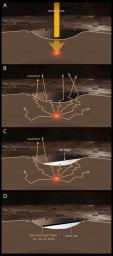Cosmic Rays Liberate Neutrons
Caption:
MESSENGER uses neutron spectroscopy to measure average hydrogen concentrations within Mercury's
radar-bright regions
. Water ice concentrations are derived from the hydrogen measurements.
(A) A galactic cosmic ray (thick yellow arrow) strikes Mercury.
(B) The cosmic ray strike liberates neutrons (thin arrows) from atomic nuclei in Mercury's near-surface material. The neutrons travel multiple meters through the surface and escape into space, where some can be detected by the
Neutron Spectrometer
on the orbiting MESSENGER spacecraft.
(C) A layer of water ice several meters thick is illustrated in white. Abundant hydrogen atoms within the ice stop the neutrons from escaping into space. A signature of enhanced hydrogen concentrations (and, by inference, water ice) is a decrease in the rate of MESSENGER's detection of neutrons from the planet.
(D) MESSENGER neutron data show that Mercury's north polar radar-bright deposits consist primarily of water ice. In most such areas, the water ice is covered by an insulating layer 10 to 20 cm thick.
Background Info:
The MESSENGER spacecraft is the first ever to orbit the planet Mercury, and the spacecraft's
seven scientific instruments and radio science investigation
are unraveling the history and evolution of the Solar System's innermost planet. Visit the
Why Mercury?
section of this website to learn more about the key science questions that the MESSENGER mission is addressing. During the one-year primary mission, MDIS acquired 88,746 images and extensive other data sets. MESSENGER is now in a year-long extended mission, during which plans call for the acquisition of more than 80,000 additional images to support MESSENGER's science goals.
For information regarding the use of images, see the MESSENGER
image use policy
.
Cataloging Keywords:
| Name |
Value |
Additional Values |
| Target |
Mercury |
|
| System |
|
|
| Target Type |
Planet |
|
| Mission |
MESSENGER |
|
| Instrument Host |
MESSENGER |
|
| Host Type |
Orbiter |
|
| Instrument |
|
|
| Detector |
|
|
| Extra Keywords |
Color, Radar, Radio, Water |
| Acquisition Date |
|
| Release Date |
2012-11-30 |
| Date in Caption |
|
|
| Image Credit |
NASA/Johns Hopkins University Applied Physics Laboratory/Carnegie Institution of Washington |
| Source |
photojournal.jpl.nasa.gov/catalog/PIA16524 |
| Identifier |
PIA16524 |

 Planetary Data System
Planetary Data System
